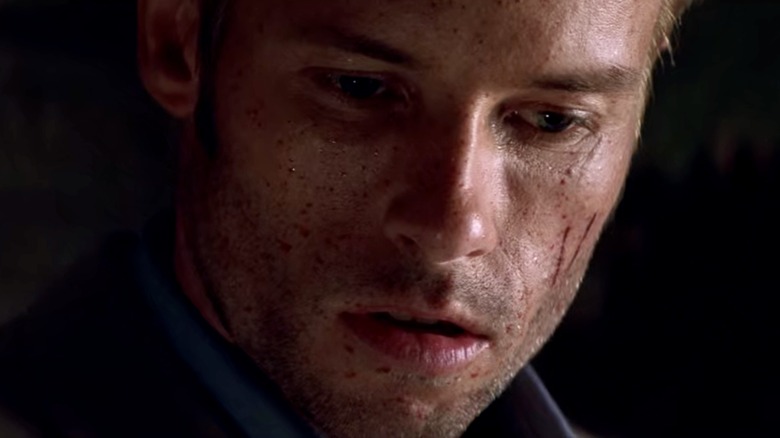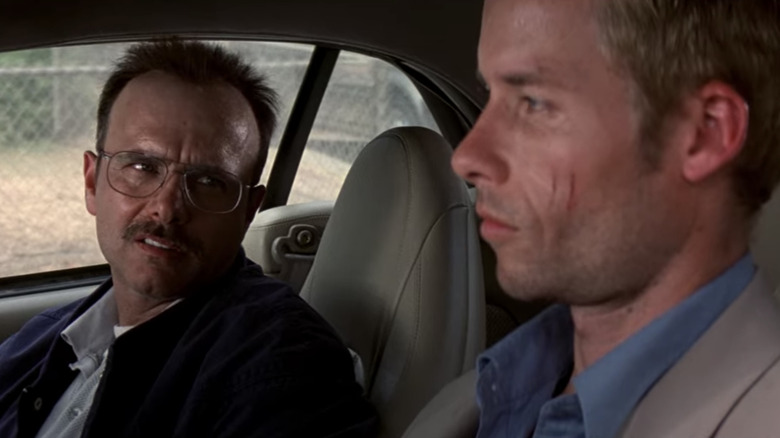How Christopher Nolan Tried To Breathe New Life Into Film Noir
Christopher Nolan's earliest films, "Following" and "Memento," are often considered neo-noir, or at the very least, noir-ish. Even as Nolan crossed over from independent features to mid-budget thrillers and eventually superhero blockbusters, his movies have retained certain noir inflections. Of course, that immediately opens up the question of, "What is noir?" Different people might define it different ways.
In an interview with Filmmaker Magazine around the time of "The Dark Knight," Nolan laid out his personal definition of noir as follows:
"For me, film noir is one of the only genres where the concept of point of view is accepted as a fairly important notion in the storytelling, and where it's totally accepted that you can flashback and flashforward and change points of view. The best film noir always involves a continuous reassessment of things, especially in terms of 'Who's the good guy?' and 'Who's the bad guy?' You want the double cross, you want the surprise, and you want to keep the audience mindful of the fact that they don't know the full story, and that they can't trust all the characters."
These elements — the flashes forward and back, the changing points of view, the double crosses — are all present to some degree in "Memento," which leverages its unique reverse-chronological-narrative concept to tell a story about the innate human tendency to live in denial. In this case, the protagonist, Leonard Shelby (Guy Pearce), can't even trust himself, let alone other people, because of his short-term memory loss.
The operative question in "Memento" is, "Do I lie to myself to be happy?" Leonard, like anyone, is liable forget the lessons he's learned and keep making the same mistakes, particularly when confronting the truth about himself and his situation is too uncomfortable or painful.
"Maybe You Should Start Investigating Yourself"
Non-linear storytelling and a fascination with time have become staples of Nolan's filmography, but with "Memento," they weren't just gimmicks. They were an attempt to situate the audience in Leonard's perspective so that we could feel as he feels and maybe, by the end, see ourselves in him. Nolan elaborated further on this and on how his definition of noir applies to "Memento," which is based on the short story, "Memento Mori," by his brother Jonathan Nolan. He said:
"When Jonah told me the story he had for Memento, the idea of relating the condition this guy has – his inability to keep memories fixed in his head – in terms of a revenge scenario, it seemed like the most interesting thing to do would be to take the film-noir approach, and to tell the story almost entirely from that character's point of view. His psychological condition and his point of view are crucial to why the structure is there: it's an attempt to put the audience inside his head, and to make them think about the characters around him and the situations he's in in the same way that he does."
This approach helped Nolan find a fresh entry point into noir, or noir-adjacent territory, and refresh tropes of the genre that had become stale. The puzzle-box aspect of the movie kept viewers on their toes so that they were not just trying to solve a crime; they were trying to solve the nature of what was even happening onscreen. Nolan concluded:
"I really wanted to use the structure of the movie as a way of reawakening some of the things that used to be so valued in the genre: the paranoia and exaggeration in our everyday insecurities. But the genre's been used so many times, you have to try very hard to find new ways to energize it. If the audience goes into Memento expecting just another film noir, I think they're going to be kind of disappointed, because it's about more than that."
Next time you watch "Memento," just remember, we're all Leonard Shelby, this person with a selective memory and a tendency toward self-deception. As Teddy (Joe Pantoliano) observes to Leonard: "Maybe you should start investigating yourself."

